Related Research Articles
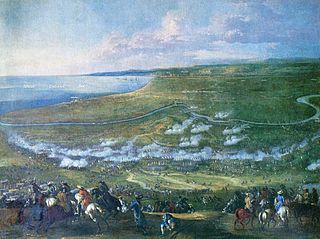
1676 (MDCLXXVI) was a leap year starting on Wednesday of the Gregorian calendar and a leap year starting on Saturday of the Julian calendar, the 1676th year of the Common Era (CE) and Anno Domini (AD) designations, the 676th year of the 2nd millennium, the 76th year of the 17th century, and the 7th year of the 1670s decade. As of the start of 1676, the Gregorian calendar was 10 days ahead of the Julian calendar, which remained in localized use until 1923.

Mendon is a town in Worcester County, Massachusetts, United States. The population was 6,228 at the 2020 census. Mendon is part of the Blackstone River Valley National Heritage Corridor, an early center of the industrial revolution in the United States. Mendon celebrated its 350th anniversary on May 15, 2017.

King Philip's War was an armed conflict in 1675–1676 between a group of indigenous peoples of the Northeastern Woodlands and the English New England Colonies and their indigenous allies. The war is named for Metacomet, the Pokanoket chief and sachem of the Wampanoag who adopted the English name Philip because of the friendly relations between his father Massasoit and the Plymouth Colony. The war continued in the most northern reaches of New England until the signing of the Treaty of Casco Bay on April 12, 1678.

Mary Rowlandson, née White, later Mary Talcott, was a colonial American woman who was captured by Native Americans in 1676 during King Philip's War and held for 11 weeks before being ransomed. In 1682, six years after her ordeal, The Sovereignty and Goodness of God: Being a Narrative of the Captivity and Restoration of Mrs. Mary Rowlandson was published. This text is considered a formative American work in the literary genre of captivity narratives. It went through four printings in 1682 and garnered readership both in the New England colonies and in England, leading some to consider it the first American "bestseller".
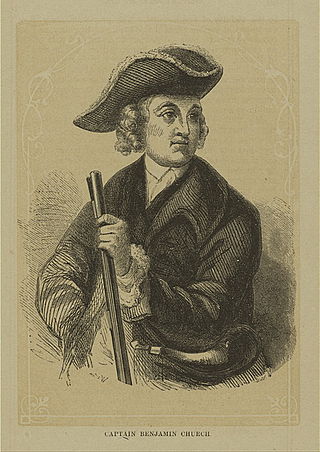
Colonel Benjamin Church was an American military officer and politician who is best known for his role in developing military tactics and participating in numerous conflicts which involved the New England Colonies. He is also known for commanding one of the first ranger units in North America. Born in the Plymouth Colony, Church was commissioned by Governor Josiah Winslow to establish a company of rangers after the outbreak of King Philip's War in 1675. A force of New Englanders led by him was responsible for tracking down and killing Wampanoag sachem Metacomet, which played a major role in ending the conflict.
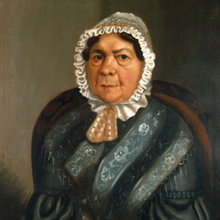
The Nipmuc or Nipmuck people are an Indigenous people of the Northeastern Woodlands, who historically spoke an Eastern Algonquian language. Their historic territory Nippenet, "the freshwater pond place," is in central Massachusetts and nearby parts of Connecticut and Rhode Island.

The Hassanamisco Nipmuc Band is the sole state-recognized tribe in the Commonwealth of Massachusetts. They were recognized in 1976 by Governor Michael Dukakis via Executive Order 126. They were briefly known as the Nipmuc Nation, a union of the Hassanamisco Nipmuc and the Chaubunagungamaug Nipmuck bands, during their attempt to receive federal acknowledgment as a Nation. The Hassanamisco Nipmuc Band owns three and a half acres of reservation land in what is present day Grafton, Massachusetts. The Nipmuc are native to Central Massachusetts, Northeastern Connecticut, and parts of Rhode Island.
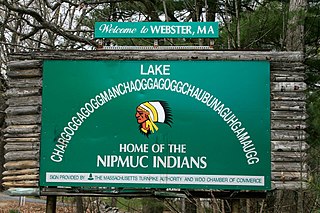
The Chaubunagungamaug Reservation refers to the small parcel of land located in the town of Thompson, Connecticut, close to the border with the town of Webster, Massachusetts and within the bounds of Lake Chaubunagungamaug to the east and the French River to the west. The reservation is used by the descendants of the Nipmuck Indians of the previous reservation, c. 1682–1869, that existed in the same area, who now identify as the Webster/Dudley Band of the Chaubunagungamaug Nipmuck. Together with the Hassanamisco Nipmuc, both have received state recognition under the Massachusetts Commission on Indian Affairs.

Simon Willard (1605–1676) was an early Massachusetts fur trader, colonial militia leader, legislator, and judge.

John Hoar was a militia leader & Indian liaison in colonial Massachusetts during King Philip's War. He is best known for securing the release of Mary Rowlandson from Nipmuc captivity at Redemption Rock. The event was depicted in the best-selling book The Sovereignty and Goodness of God: Being a Narrative of the Captivity and Restoration of Mrs. Mary Rowlandson.
Muttawmp was a sachem of the Nipmuc Indians in the mid-17th century, originally based in Quaboag. He participated in King Philip's War, taking part in most of the major engagements as one of the most important chiefs who fought for Metacomet.
Matoonas was a sachem of the Nipmuc Indians in the middle of 17th century. He played a significant role in the Native American uprising known as King Philip's War.

The Battle of Turner's Falls or Battle of Grand Falls; also known as the Peskeompscut-Wissantinnewag Massacre, was a battle and massacre occurring on May 19, 1676, in the context of King Philip's War in what is present-day Gill and Greenfield, across from Turners Falls on the Connecticut River. The incident marked a turning point in the war, and in the colonization of Native lands by British settlers. The war led to the expulsion of most Native Americans in the Connecticut River Valley.

The Sudbury Fight was a battle of King Philip's War, fought in what is today Sudbury and Wayland, Massachusetts, when approximately five hundred Wampanoag, Nipmuc, and Narragansett Native Americans raided the frontier settlement of Sudbury in Massachusetts Bay Colony. Disparate companies of English militiamen from nearby settlements marched to the town's defense, two of which were drawn into Native ambushes and suffered heavy losses. The battle was the last major Native American victory in King Philip's War before their final defeat in southern New England in August 1676.

The Lancaster Raid was the first in a series of five planned raids on English colonial towns during the winter of 1675-1676 as part of King Philip's War. Metacom, known by English colonists as King Philip, was a Wampanoag sachem who led and organized Wampanoag warriors during the war. Teaming up with Nipmuc and Narragansett warriors, the Wampanoag successfully raided the town of Lancaster, securing provisions and prisoners to help them carry on into their winter offensive.
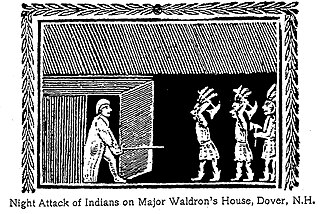
The Raid on Dover took place in Dover, New Hampshire, on June 27–28, 1689. Led by Chief Kancamagus of the Pennacook, it was part of King William's War, the North American theater of the Nine Years' War (1688–1697), fought between England and France and their respective Native allies.

Tantamous was a well-known Native American Nipmuc leader in seventeenth century Massachusetts. Tantamous was a powwow who lived near the Assabet River, later in Nobscot. Tantamous "...may have gotten his English name for his good advice."

John Wompas was a Nipmuc Indian man born around 1637 in Nipmuc Country, in what would become the state of Massachusetts. He spent the first half of his childhood among his Native kin and the second half living with an English family in Roxbury, Massachusetts Bay Colony. This dual upbringing gave him fluency in the languages and customs of both Nipmuc and colonial English worlds. He used his cross-cultural knowledge largely for personal economic and political gain, but at the end of his life he also turned it to the benefit of his Nipmuc kin.
Peter Jethro was an early Native American (Nipmuc) scribe, translator, minister, land proprietor, and Praying Indian affiliated for a period with John Eliot in the praying town of Natick, Massachusetts.
Rev. Hope Atherton (1646–1677) was a colonial clergyman. He was born in Dorchester, Massachusetts. Harvard Class of 1665. He was the minister of Hadley, Massachusetts. He served as a chaplain in the King Philips War and became separated from troops during the Battle of Great Falls in 1676. He died months after the battle, aged 30.
References
- 1 2 Ricky, Donald (1 January 1998). Encyclopedia of Massachusetts Indians. Somerset Publishers, Inc. pp. 170–171. ISBN 978-0-403-09330-4. Archived from the original on 5 September 2023. Retrieved 4 September 2023.
- 1 2 3 "Wunnuhhew (Sarah Doublet)". Freedom's Way National Heritage Area. Archived from the original on 5 September 2023. Retrieved 5 September 2023.
- ↑ Ellis, George; Morris, John (1906). King Philip's War. New York: Grafton Press. pp. 215–216. Retrieved 4 September 2023.